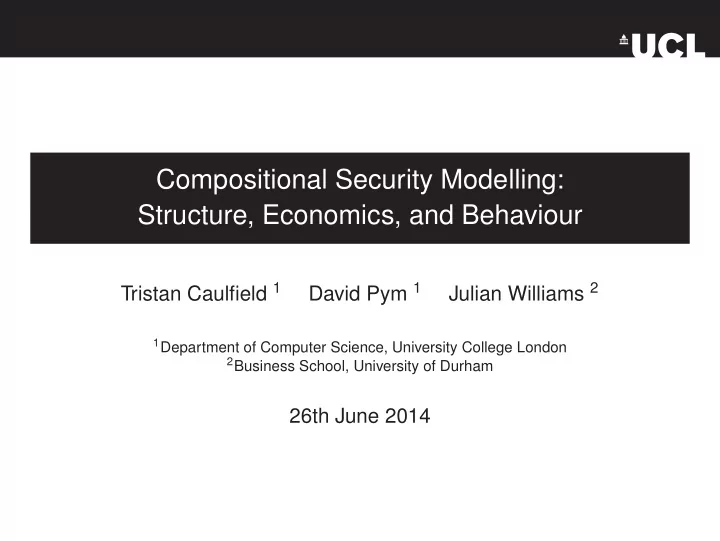

Compositional Security Modelling: Structure, Economics, and Behaviour Tristan Caulfield 1 David Pym 1 Julian Williams 2 1 Department of Computer Science, University College London 2 Business School, University of Durham 26th June 2014
Security Policy Security managers must choose policies. Subject to economic and regulatory constraints. Security policies are often onerous and can inhibit productivity. Employees circumvent them to fulfil higher priority tasks (i.e. work). Currently hard to analyse consequences of policy decisions. Managers must rely on their own judgement. Difficult to show how optimal these decisions may be.
Goal Develop a framework for modelling security policy decisions and consequences. Capture not just policy, but also system architecture and user behaviour. Express the optimality of decisions in terms of security manager’s preferences. Should be compositional. Allows complex systems to be divided into manageable pieces. Lets us examine the interactions between models.
Approach Develop a framework based on Distributed Systems Modelling Offers a convenient abstraction. Rigorous mathematical treatment. Processes : process algebra. Resources : resource semantics, BI, separation logic. Locations : directed graph-like structure. Environment : stochastic processes. Does an action happen? Implement a framework and models in the Julia language.
Agents and Decisions Agents have preferences. For productivity, security, individual welfare, etc. Make decisions based on these preferences and on the current state of the model. Decisions are in Cobb-Douglas form: D = δ X α Y β X and Y are values of different alternatives. α and β are the relative likelihood of these alternatives. ( α + β = 1) Allows for composition.
Security Manager’s Utility Each model execution has a set D of decisions made. λ i 1 λ ik D = { D i = δ i X . . . X | i = 1 , . . . , m } i 1 i k Security managers care about particular attributes. These are determined by decisions in the model. An attribute V has a target value, ¯ V . A manager assigns a value to the deviation from the target value f ( V − ¯ V .) Overall Expected Utility � n � � w r f r ( V r ( D 1 , . . . , D m ) − ¯ E [ U ( D 1 , . . . , D m )] = E V r ) r = 1
Models Tailgating Reception Break After Lobby O ffi ce Room Door Interior Home Reception Desk Badge Rest room Lobby Street (environment )
Models Composed Reception Another model: Screen Locking. Other Room Composed with tailgating model. Break After Lobby O ffi ce Room Door Allows us to examine interactions between models. Home Do entry security controls mitigate lapses in other areas?
Results Rec Grds Prod Sec Wait Tail Succ Access 60 0 0.2 0.2 1995.73 9.56 5.42 8.76 60 0 0.8 0.2 929.68 11.58 5.47 10.48 120 0 0.2 0.2 3156.48 12.78 5.20 9.05 120 0 0.8 0.2 1517.90 14.62 6.15 13.63 60 1 0.2 0.2 1863.38 8.13 1.50 3.27 60 1 0.8 0.2 1160.51 12.80 2.53 6.00 120 1 0.2 0.2 4126.91 12.85 2.17 5.68 120 1 0.8 0.2 1981.08 15.50 2.48 4.02
Further Work Mathematical definitions of models and composition. Library of scenarios. Integration of modelling and data collection. Thanks! Any questions?
Recommend
More recommend